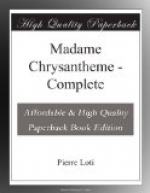Along the streets leading to the temple, the wealthy inhabitants have decorated the fronts of their houses with vases and nosegays. The peculiar shed-like buildings common in this country, with their open platform frontage, are particularly well suited for the display of choice objects; all the houses have been thrown open, and the interiors are hung with draperies that hide the back of the apartments. In front of these hangings, and standing slightly back from the movement of the passing crowd, the various exhibited articles are placed methodically in a row, under the full glare of hanging lamps. Hardly any flowers compose the nosegays, nothing but foliage—some rare and priceless, others chosen, as if purposely, from the commonest plants, arranged, however, with such taste as to make them appear new and choice; ordinary lettuce-leaves, tall cabbage-stalks are placed with exquisite artificial taste in vessels of marvellous workmanship. All the vases are of bronze, but the designs are varied according to each changing fancy: some complicated and twisted, others, and by far the larger number, graceful and simple, but of a simplicity so studied and exquisite that to our eyes they seem the revelation of an unknown art, the subversion of all acquired notions of form.
On turning a corner of a street, by good luck we meet our married comrades of the Triomphante and Jonquille, Toukisan and Campanule! Bows and curtseys are exchanged by the mousmes, reciprocal manifestations of joy at meeting; then, forming a compact band, we are carried off by the ever-increasing crowd and continue our progress in the direction of the temple.
The streets gradually ascend (the temples are always built on a height); and by degrees, as we mount, there is added to the brilliant fairyland of lanterns and costumes yet another, ethereally blue in the haze of distance; all Nagasaki, its pagodas, its mountains, its still waters full of the rays of moonlight, seem to rise with us into the air. Slowly, step by step, one may say it springs up around, enveloping in one great shimmering veil all the foreground, with its dazzling red lights and many-colored streamers.
No doubt we are drawing near, for here are steps, porticoes and monsters hewn out of enormous blocks of granite. We now have to climb a series of steps, almost carried by the surging crowd ascending with us.
We have arrived at the temple courtyard.
This is the last and most astonishing scene in the evening’s fairy-tale—a luminous and weird scene, with fantastic distances lighted up by the moon, with the gigantic trees, the sacred cryptomerias, elevating their sombre boughs into a vast dome.
Here we are all seated with our mousmes, beneath the light awning, wreathed in flowers, of one of the many little teahouses improvised in this courtyard. We are on a terrace at the top of the great steps, up which the crowd continues to flock, and at the foot of a portico which stands erect with the rigid massiveness of a colossus against the dark night sky; at the foot also of a monster, who stares down upon us, with his big stony eyes, his cruel grimace and smile.




